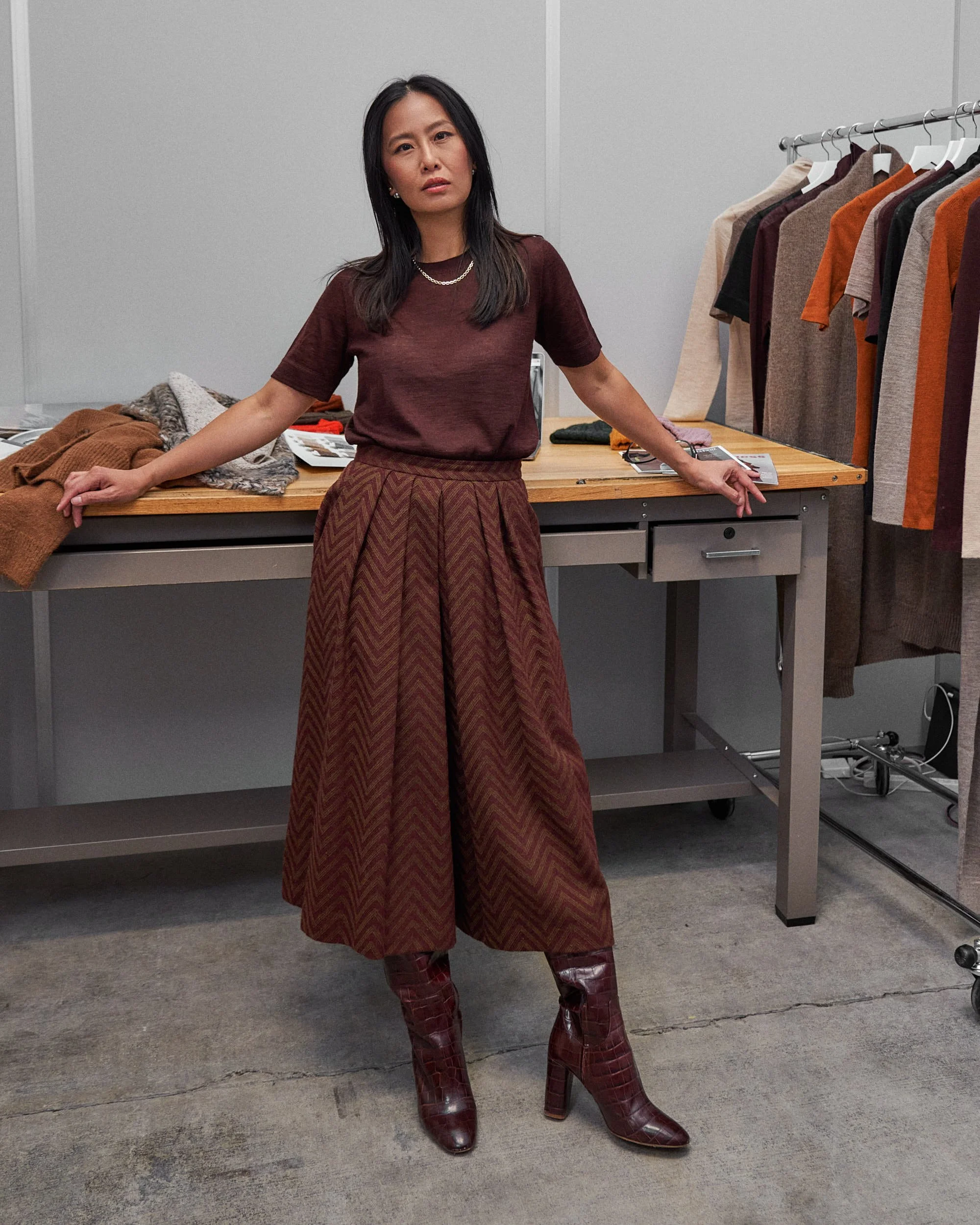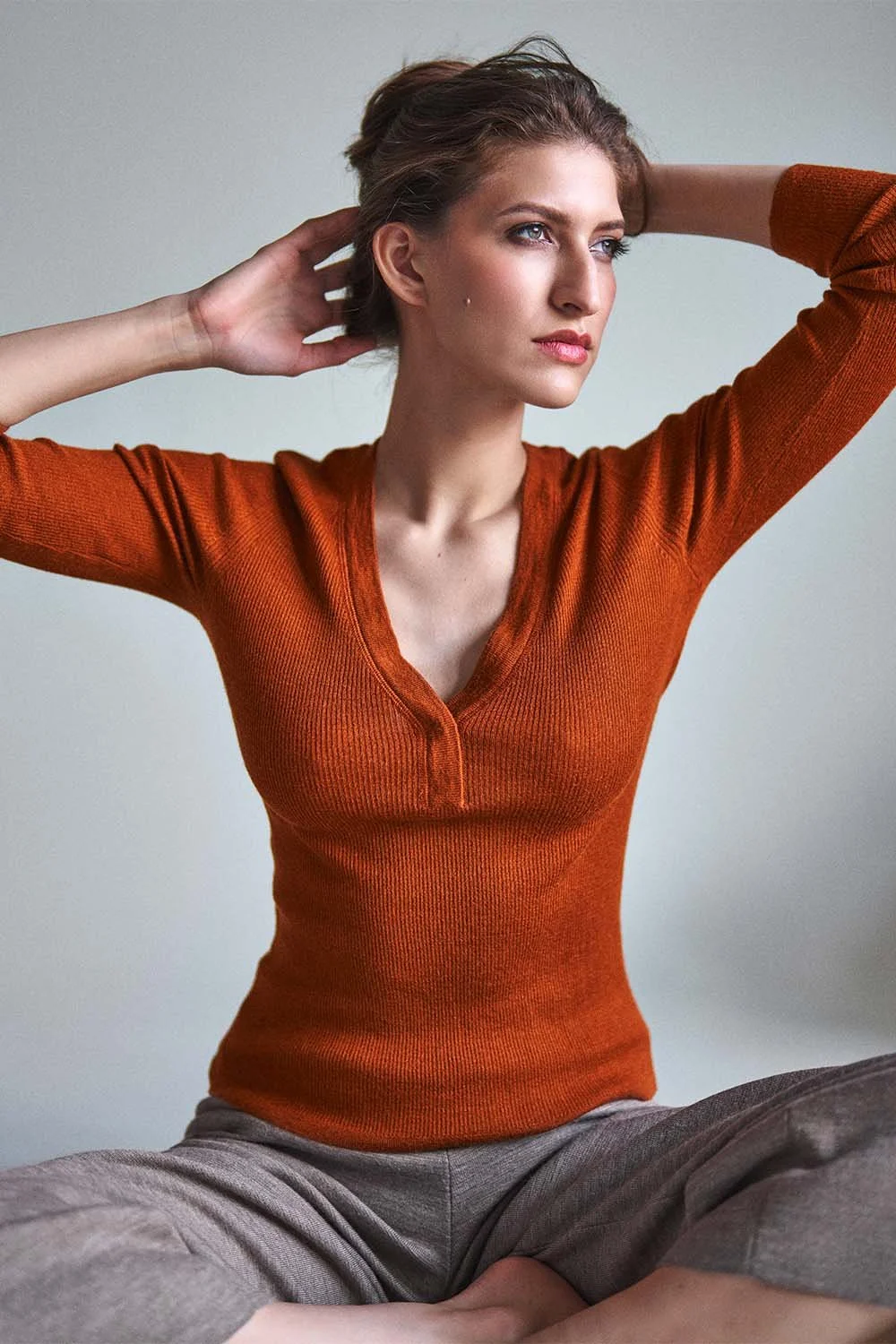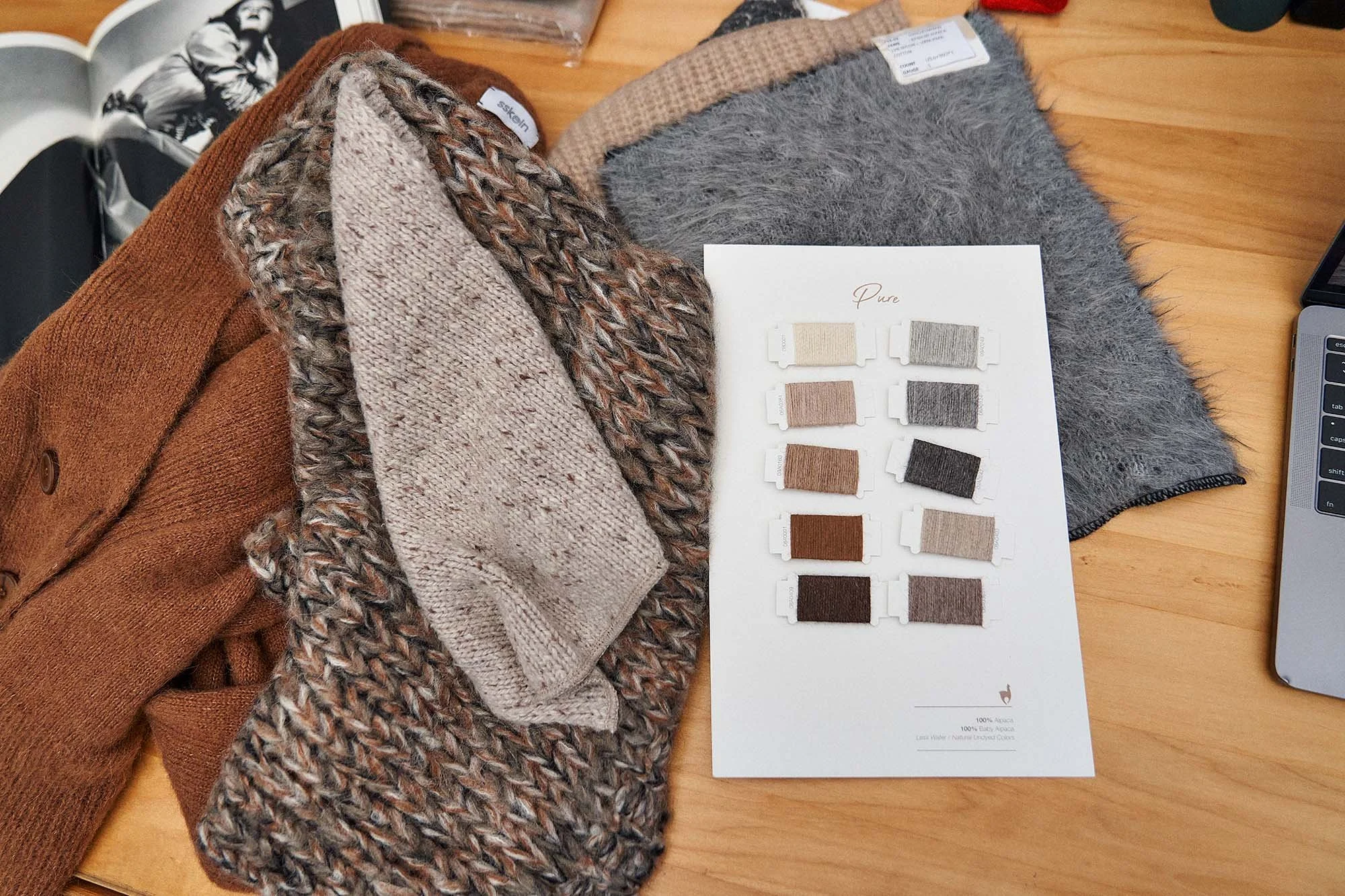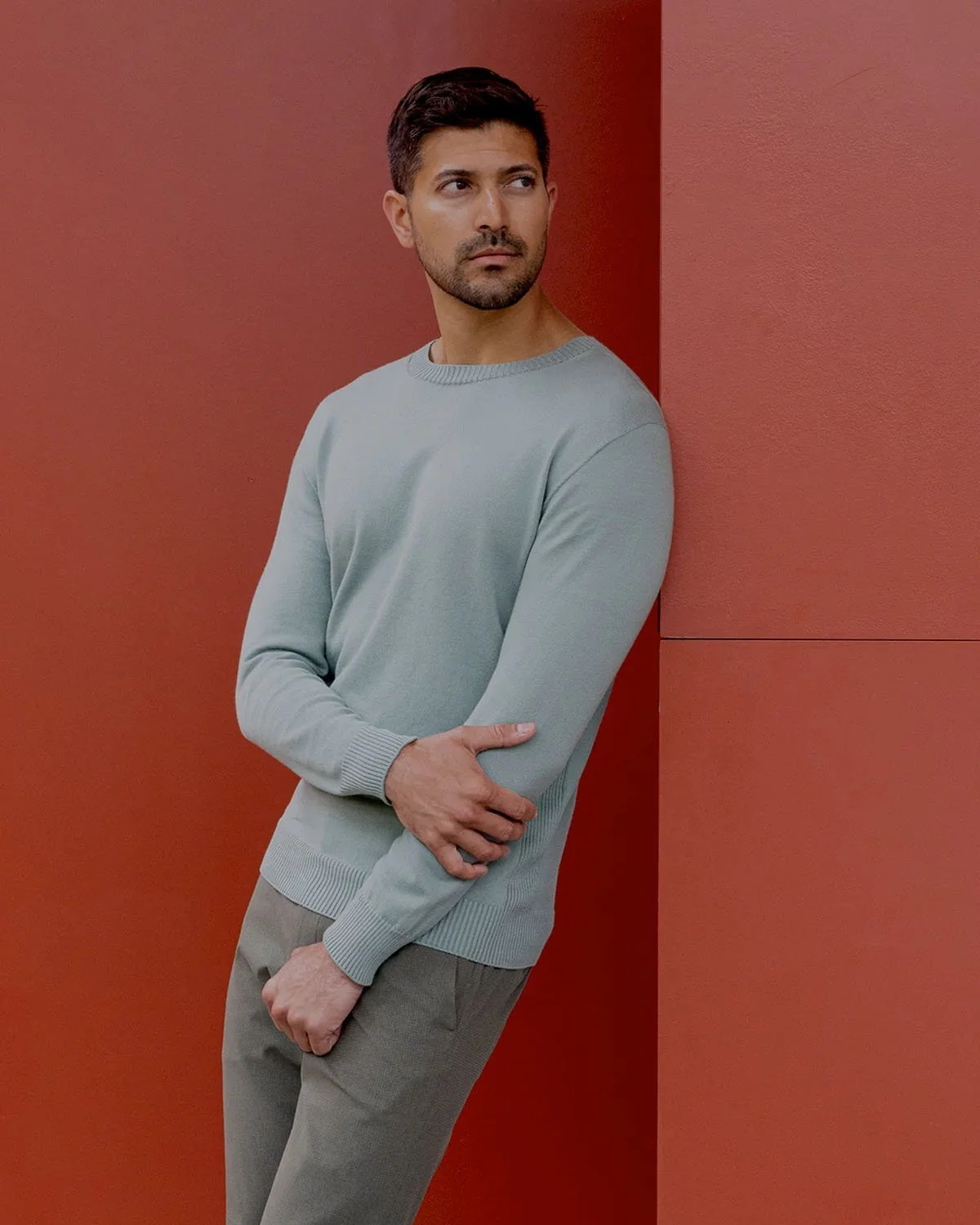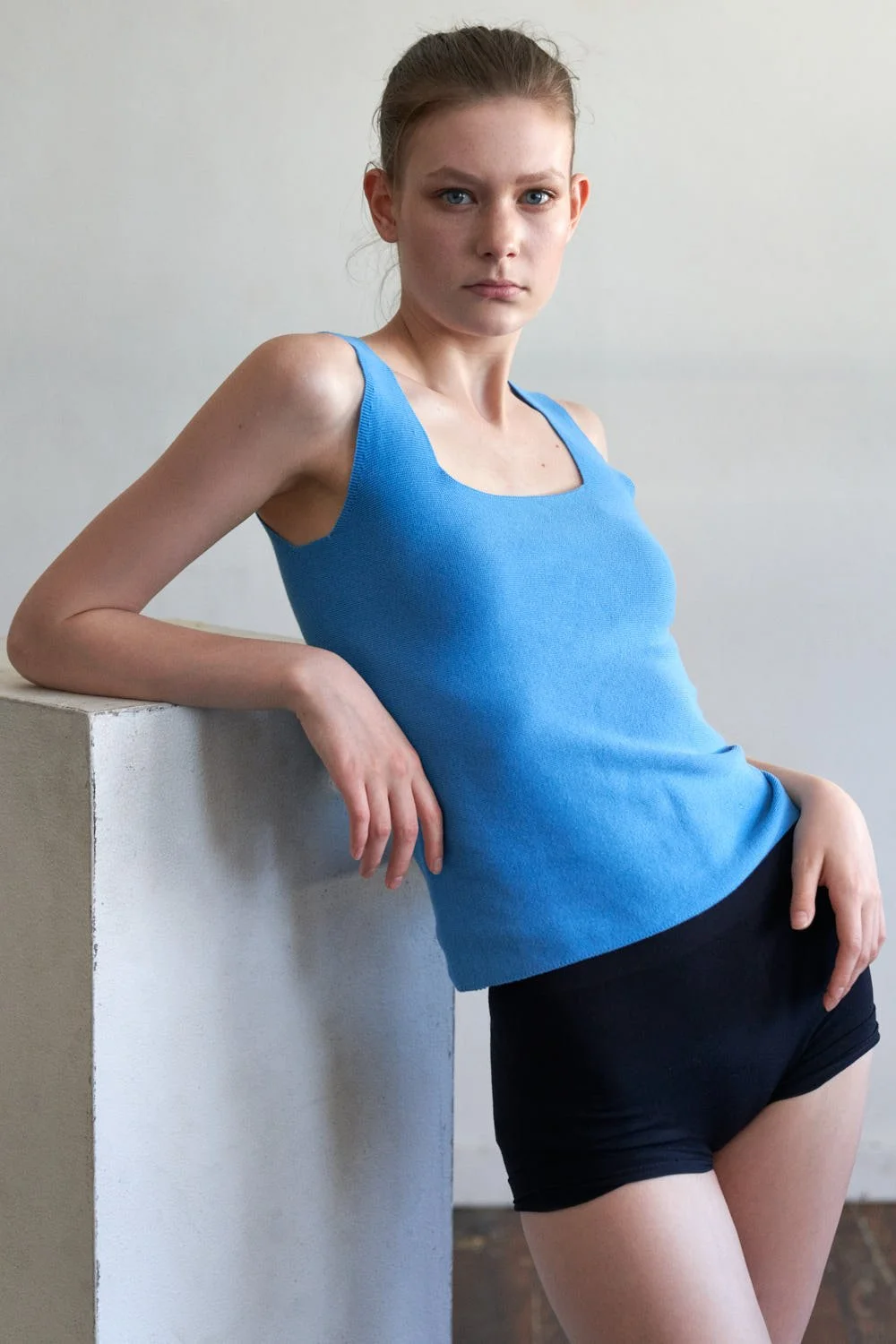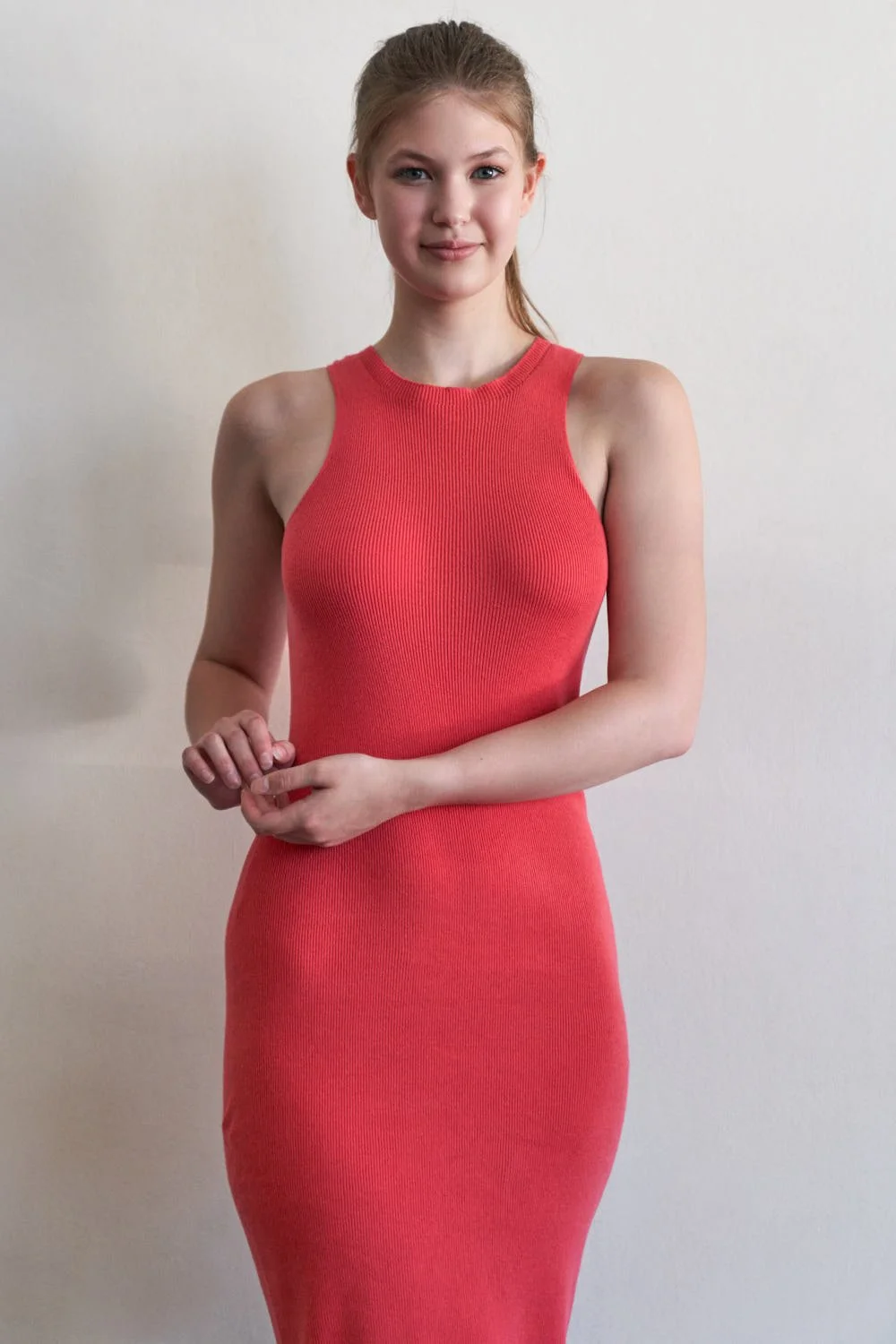
Elisa Yip is the Founder and Creative Director of Sskein based in Seattle, Washington. Sskein is a luxury knitwear company focused on ready-to-wear basics made from alpaca wool in small batches, though have recently embraced emerging technologies and Egyptian cotton textiles.
In addition, Sskein Studio is an extension of Elisa’s knitwear expertise that offers design services, R&D, and production consultations.
Elisa’s formal education came by way of Fashion Institute of Technology which included a summer program in Italy where she gained key insights from, and an appreciation for, luxury textiles and fine tailoring.
After working for various design studios and larger brands, Elisa landed in Seattle where she enjoyed a successful career as a knitwear designer for Nordstrom. In 2020, Elisa founded Sskein with a mission to provide luxury knitwear in the most sustainable way possible. Her design philosophy bridges the gap between artisan practices and emerging technologies to bring her vision of sustainable luxury to life.
Elisa Yip
BORN : United States
RAISED : New York
EDUCATION : Fashion Institute of Technology
EXPERIENCE : DESIGNER, NORDSTROM PRODUCT GROUP
LABELS : 1
FOCUS : PRÊT-À-PORTER
STUDIO : YES
LOCATION : Seattle, WASHINGTON
A version of the following article appeared in The Winter Issue in 2021 and has been updated to include new collections and recent changes. Interviews with Elisa were conducted in 2020 and 2021, and reflect the realities many faced during the COVID-19 pandemic.
Future fashion historians might look back on Pacific Northwest trends in 2021 with a sense of familiarity. For all that's changed in our daily lives over the past 18 months, style remains firmly grounded in convenience as themes of comfort and utility maintain their critical orbits around lives that generally remain grounded in our homes.
As it pertains to knitwear, few designers have radically deviated from this template, favoring practicality with comfortable fit, thermal regulation, durability, and sustainability at the top of the prioritization list. After all, artistic interpretations and reinventions, whilst both groundbreaking and breathtaking, generally take a backseat for a population concerned with workplace appropriate tailoring and staying warm on a blustery Northwest day.
But these limitations have led to incredible innovation as our collective definition of art and fashion evolves around the science that upholds them. For creators and consumers that value reducing garment waste as well as achieving a net zero carbon footprint, the innovation must necessarily utilize out-of-the-box thinking as we use the vehicle of Fine Art to inspire technological answers to some of our most difficult questions. As Einstein said, “We can't solve problems by using the same kind of thinking we used when we created them."
So how do we elevate our sense of style whilst simultaneously reducing the expansion of grazing lands, eliminating toxic textile dyes, and designing processes that don't put tons of plastic into our oceans and carbon into our atmosphere? The answer is nothing new, but requires something that perhaps we haven't seriously considered—Time.
Early 2020 showed us just how fast the many global ecosystems can recover if human interventions ceased entirely. In many ways, a return to artisan practices and ancient wisdom, paired with time and intentionality, can significantly position our industry for a far more sustainable future. This is the perspective shared by Elisa Yip, Founder and Creative Director of knitwear label Sskein, whose artistic vision for a slow-fashion approach that addresses practical needs provides a fitting blueprint for solving even the most difficult problems. It starts with artistic inspiration and ends with a slow-fashion plan.
Sskein Alpaca Selections from our Summer 2022 Issue.
SEW IT BEGINS
"I think I find inspiration every minute of the day, all around me, especially while traveling. Unfortunately, it hasn't been that way recently. When people ask me what inspired my latest collection—um, the pandemic? It's not a trip to Bali. But honestly, the pandemic inspired me to create more pieces that I wanted to wear at that time, what I was feeling at that time."
While present fashion inspiration and trends are fittingly influenced by current needs, there is a clear thread that runs throughout Elisa's fashion journey. And as with so many others who've found their way into this industry, their fashion origins are a family affair.
"I've always received fashion inspiration from my mom. She loved fashion—knew about Louis Vuitton and Gucci back in the 80s before Tom Ford came on the scene—and I kept hearing about it because that's all she wanted from my dad. I still have all her bags she bought before they were cool. I remember when I was ten, we took a trip to Hong Kong so that she could buy luxury bags there. In Hong Kong in the 60s, her first job was to bead velvet slippers by hand in a Chinese factory. When she came to the United States, she was a seamstress. She's always been around fashion—used to buy those old Vogue patterns and make her own clothing. For her, it was always about color, pattern, and importantly, creating things with her hands. And as I grew up, I remember taking bedsheets, wrapping them around myself, and walking around the house like it was my own private runway show. So fashion was always around me, even from an early age."
"Later on, I didn't really know what I wanted to do for a career. I was a computer science major, but really only because my friends were there. And all I really wanted to do was chase boys and hang out with my friends! But I got into LaGuardia High School of Music & Art in New York only to turn it down to go to a business school. I knew I wanted to do something creative, but I didn't want to be in fine arts because, at the time, I thought you couldn't make any money with that. But I remember going to the MET on a date with an old boyfriend, and it was there that I saw the The Costume Institute before Anna Wintour's rebrand. I remember it was downstairs in a dark basement and there were all these 19th century clothing pieces behind glass walls with lighting on them. I just remember walking up to the glass and thinking, "This—this is what I want to do for the rest of my life." I wanted my clothes to be behind that glass one day. So that's when I decided to go to fashion school."
"I wanted to apply to [Fashion Institute of Technology] but when I read the requirements, it said I needed a portfolio. So I took a sketching class in the summer, created a portfolio, submitted my application, and six months later, got into FIT. It was the only school I applied to so it was just meant to be. And that's how I really got into the fashion industry—it was from my mom."
NEW YORK STATE OF MIND
"At the time, I didn't realize how much work it took to be part of that program at FIT. There were times I'd stay up really late in the studio, which shuts down at two in the morning. So what did I do to stay up? Smoke cigs in the staircase. But I mean, it was on the eighth floor and it was super late! So we'd take a drag, hear a door squeak, and run away like roaches. But sleep was something of a luxury then. This other time I didn't sleep for three days. I remember sewing a muslin garment in a tailoring class, and on that third day, I was working as a waitress and on that evening shift, I fell asleep standing up against a wall. The next day I slept for like 20 hours. But honestly, it was really getting me ready to be in this industry. That's just how hard I worked. And a lot of people don't make it out of there. Maybe 30% of people don't graduate, they drop out. But I had the grit. I knew I was going to make it. There was nothing else I wanted to do."
"One of my best experiences during those times was actually studying abroad in Italy for my third year. It was an incredible experience. I was on my own for the first time and got to really become the adult I was to going to be. And the people just stand out to me so much. They just absolutely love craft and want to share it with everyone. And they're so stubborn about what they do! But that's because it's to perfection. That's why Italy is Italy. I made so many friends there. The partying was awesome. And every time you go back, even now, it's still the same. You might find a Starbucks, but you won't find any new buildings. It just feels like you've never left. These days, as a knitwear designer, I still notice that the meticulous craft of knitting things to perfection is definitely still there. There are still family owned businesses passing traditions and techniques to the next generation. Just watching how people dress, you can tell from Italians—by the way a suit will fit them like a glove, even old men look sexy! And the away they carry themselves is so confident. They're like, "I'm the hottest shit!" It's where I really picked up that what you wear exudes the personality that you put out there, how you feel about yourself and how you carry yourself. Unfortunately, fewer and fewer people are learning that craft. I hope that it never goes away. And the same can be said of China, too. Younger people don't want to do factory work—they want to do tech or gaming."
Elisa took her experiences to heart. After graduating from FIT, she worked for several fashion houses before landing her longest-running job at Nordstrom working directly with knitwear. And like so many others that work throughout the fashion industry, she became aware of the darker impact the industry was creating on our local environments and global communities. But it wasn't until 2020 when her life was affected by personal tragedies that she put her vision for knitwear into action, founding Sskein to address the needs of a luxury market that demanded better from an industry then reeling from a complete shutdown at every level.
"When you start out in fashion school, you generally want to start your own brand someday. You don't just want to go to work for somebody else. You'll have to do it to get experience, but ultimately, you want to see your designs coming down the runway. That's the pipe dream. And for me, it kind of got lost along the way. I ended up chasing the money, chasing the easy path, because eventually you grow up and think, "Yeah, I'd love to take this trip," and, "Yeah, I want to live that life," so I got a corporate job. I could have started a design firm, but again, really wanted security. Don't get me wrong, I learned a lot and am grateful for all these experiences. But I got too comfortable. I was really scared of doing something on my own. It wasn't until last year that life really hit me. I lost my father, and due to the pandemic, lost my job. And it was a friend that reminded me, "Hey, you didn't go to medical school to become a nurse—you wanted to be a surgeon." What they were trying to say was that I didn't go to fashion school to not build my own brand. So I finally stepped out on my own. I started out not knowing what I was doing and I learned very quickly that there's always something else to learn. And being uncomfortable is good."
ALPACA OBSESSION
"With knitwear, I chose to work with alpaca because it's a luxury fiber that's sustainable, practical and versatile. Having been in the fashion industry for so long, I've seen waves of high fashion and fast-fashion and it's terrible how much waste there is and how much we've polluted our planet. When I started Sskein, I knew I wanted to be responsible with anything I created, and I also wanted the best-of-the-best textile. I didn't want to settle. And that's what led me to 100% baby alpaca, which I now use wherever I can. I remember early on, I was going to place an order for a synthetic blend to try and satisfy a lower price point. But my husband reminded me, "Hey, that's not your brand. That's not what you're about." And that just confirmed it for me. Alpaca may not be for everybody. But if you really love well-made clothes, it's for you. And if you want to reduce your carbon footprint, it's definitely for you."
"Alpaca fibers generally come from Peru, but can be found in other places in South America. People there have been using alpaca fibers for centuries. There's a relationship between alpaca and the surrounding environment, from the way they eat, to the overall impact their hooves have on grazing lands—even the grass regenerates better. Alpaca fibers are naturally hypoallergenic unlike sheep or other similar animals, reducing allergic reactions. The fiber is also hollow, so it traps and helps regulate heat. And because the fibers aren't barbed or frayed, it's very slick and smooth to the touch, even allowing water to roll off when it rains, which is perfect for places like right here in Seattle. You don't need a lot of alpaca to stay warm. I really think it's the next big thing in America that people will want to wear once they see what it can do. Cashmere for example became a bit too attainable, which has its own issues with quality, cost and overproduction. But for now, alpaca is definitely a wonderful fiber that people should experience for themselves."
"The person I design for at Sskein can be thought of in two main segments, but generally, they're about 35-65 and love well-made clothing. Perhaps they're a very busy person, in charge of their own destiny, caring about the planet, wanting something that's easy to dress in, loves pieces that are timeless and go with the rest of their wardrobe. The younger person might be in a position where they want to save up for something meaningful that will last them many seasons. And those perhaps 45 and up have the money and have no problem buying several garments and they do so because they love those pieces, how they feel, and even how much time they save. But everyone can own them for a long time because they see the value. That's by design. Sskein was always intended to be with you through the seasons. And in that way, it helps reduce waste when we buy less often as we all commit to greater sustainability in our wardrobes and our lives as well."
CREATIVITY 101
"My creative process generally starts with me asking, What do I want to wear at this time? I remember starting with the Bare Essentials collection thinking I wanted really super-fine, lightweight, luxury pieces that I could wear pretty much all year round and be able to layer them or wear them by themselves. So I guess my process starts with a practical need and what I'm feeling at that moment. And in a lot of ways, I'm really designing for myself. But I'll think of women, generally, very busy, perhaps a mom, and ask what do they want to wear? What brings value to them? How do they achieve a non-fussy closet? Just make things very easy. So the process breaks down to this: What do I want to wear? How do I want it made? How do I want to feel wearing it? And after that, I'll think about when I should drop it based on exactly when I want to wear it. For Bare Essentials, it's all year long, but for a chunky sweater, cozy, comfortable, warm, it'll be October through the winter. I never really look at what's trending on the runway. That's not what Sskein's all about. We're about collecting collectibles, caring for them, and having them for a long time."
"After the initial creative process is figured out, I'll look at the yarn itself, which in this case, is at least 70-80% baby alpaca, all-natural. Then stitches, weight, neckline, because it's all about the string when it comes to knitwear. Do I want to ply it up or down? And the weight itself directly correlates to the price, so where do I want this garment to be priced at? So there's all this math and science and art that comes together when it comes to knitwear. And I've found it takes a rather unique kind of person to really grasp all that. You're starting with a string, basically, and turning it into a 3D piece of art."
"Then I look at color. For Sskein, we use mostly neutrals because that helps add to our sustainability plan. Neutrals go with everything, so you're more likely to get the most out of the garment across time. It's also why we don't use trend colors. Even I'm guilty—there was a lavender moment a few years ago and I have all these lavender clothes I don't wear anymore. But my camel, oatmeal, grey, black—I wear those all the time. So it was just another lesson of how we can design sustainability into our wardrobes through color selection. We might do a pop of color here and there, but those would be for a reason and in limited quantities."
"The next step is sketching on computer. I don't even sketch by hand anymore, even though I was trained that way. I'm just so used to Illustrator right now. And honestly, the hardest part about this process is that I'm a solopreneur. I don't have a design director to run ideas through like I did at Nordstrom. Everything's on me. I might ask a friend, but they won't understand the sketches. So I really have to trust my gut. And once everything's done, I'll send the tech pack overseas and four weeks later I'll get the sample back. I'll try it on, make any changes. And if it gets approved, I'll get a photoshoot sample in all the colors. Then we'll book a fashion shoot, launch it in two weeks, pre-sell it on the website, get my orders in. 6-8 weeks later, I'll get my production orders, send them out and sell whatever's left. And that's the whole process, start-to-finish."
Knit-To-Order
"Made-to-order tailoring is how the fashion industry might phrase a pre-order business model, which is useful to minimize overproduction. What Sskein is trying to do is only produce what people will actually buy. So with our Knit-to-Order business model, we're essentially borrowing from the standard pre-order model where customers will make a purchase based on what they see online or interact with at a pop-up. That means we don't hold unnecessary inventory, which reduces our costs and ultimately makes the brand more sustainable. The key to all of this is time. It still takes 6-8 weeks for a production run to get back to us, but the benefit is that it allows me to work more closely with customers, ordering only the sizes, colors and quantities just for them and greatly reducing the risk of production overruns and garment waste. Manufacturers still have MOQs (Minimum Order Quantities) but in this way we're really partnering with the customer to create a long-term relationship that empowers us all to create small changes that make an impact in our industry."
In 2022, for the sake of clarity, Sskein have rebranded their sustainability messaging away from “knit-to-order.” Their business model remains largely unchanged. However, according to Sskein, the term “knit-to-order” too closely resembles a bespoke business model, which Sskein have never adopted. Instead, they have been and will continue focusing on prêt-à-porter knitwear and will adopt new technologies that align with their core values.
MARY'S PLACE
"Sskein has always been about finding ways to give back to our community. Even though we're very new, we wanted to do something and set a standard for addressing local problems, and one of the more pressing issues right now is our homeless communities. But I thought, what do we make? We make knitwear. So what could we provide? That's when I thought about beanies. So we partnered with Mary's Place which has always been on our radar because they're so good at what they do. Their focus is on women and children and they partner with large companies to try and address needs within our communities."
"It must have been fate. I remember having it in my mind to meet with Mary's Place. So I was going about my day on the way to another meeting and just happened to knock on their door. I was greeted by [Mary's Place] Chief Development Officer and I thought, Whoa! I was on the spot, but I just gave them my pitch right there and they said, "Let's do this!" So we had been talking since February and everyone's very excited. We're going to go live with the campaign in the middle of October where we focus on a buy-one-give-one model where every beanie sold means that Mary's Place will get one for someone in their community. We had to order so many [beanies] that [the beanies we donate to Mary's Place] won't be exactly the same ones that customer will receive, since we didn't know the sizing, color or anything. But everyone so far has been super open to this and we can't wait for the campaign to go live. We want to do more of this moving forward and we really want to share these stories everywhere we can. Generosity is something everyone can be a part of and this is just one way we can try to make an impact this season."
Fresh Looks
In summer 2022, Sskein have hit the ground running with their latest capsule collection called Color Coded, their first to feature 100% Egyptian cotton spun in Italy and 3-D knit in New York. This is also Sskein’s first collection to include Menswear, signaling a clear shift toward greater inclusion as the company expands in the future.
According to Sskein, Color Coded is inspired by the architecture and oeuvre of mid twentieth century design, with specific callbacks to 1960’s nostalgia and colorways including Coral, Tangerine, Sage and Marine. While the capsule offers something for everyone, including dress and cardigan options for women, the collection is perhaps best exemplified by the shift towards activewear with hoodies and polos that are luxurious yet machine washable.
SS22 Color Coded Egyptian Cotton Capsule Selections
ADVICE FOR YOUNG DESIGNERS
"Definitely get a few years of experience in someone else's company. Roll up your sleeves. There is no job beneath you. Do everything. That's the only way you learn. Try not to make too many mistakes, but definitely make them on someone else's dime. It's just really difficult to start your own business for the first time. Do everything you can to be prepared."
"I've noticed a lot of new designers are doing things on their own. And it's easier to do that now than when I was in school 20 years ago. Back then I thought the way to build a business was to have your collections at runway shows and try to get them into department stores. But that's not the case anymore. You can have your own store on your own website. You don't need a Buyer because your customer is your buyer. You don't need a fashion show because you have social media. It's so much easier to start. So my perspective has changed completely. Anyone can go online and sell stuff. The hardest part now is probably building the brand, which just takes time. It's still really difficult. But if you have the vision, the grit, and you're resourceful, you can do anything. So take a few years to really learn. Fly under someone's wing. And when you're ready to fly on your own, you'll know."
“Fly under someone’s wing. And when you’re ready to fly on your own, you’ll know.”



